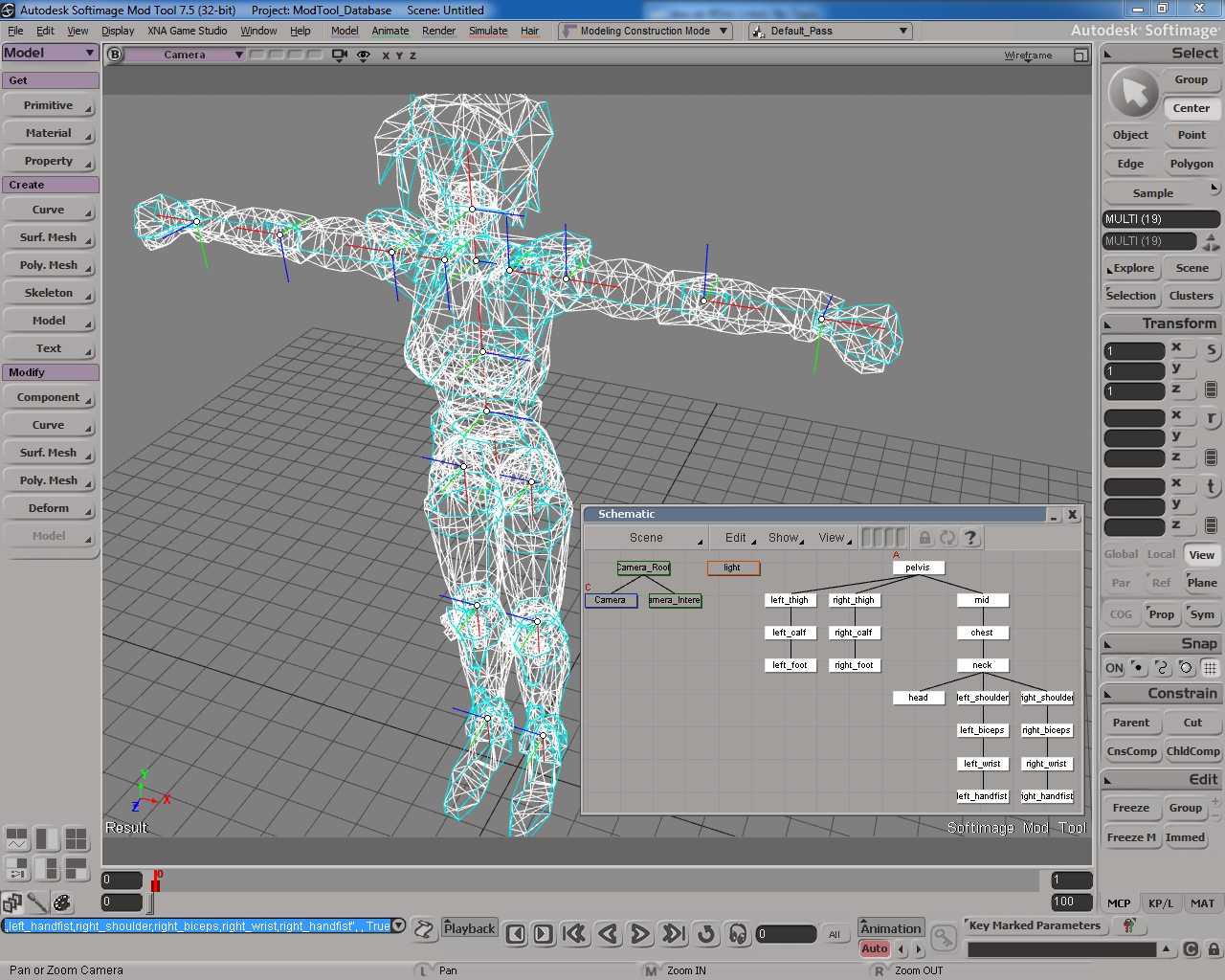XML:TRBS: Difference between revisions
Paradox-01 (talk | contribs) (Created page with "__TOC__ {{Template:XMLModdingHints}} {| border=0 cellspacing=20 cellpadding=0 style="margin-left:auto; margin-right:auto" <!--|The xml code on this page is compatible with o...") |
Paradox-01 (talk | contribs) m (using new tree list for file structure :)) |
||
| (18 intermediate revisions by 3 users not shown) | |||
| Line 1: | Line 1: | ||
{{XML_File_Header | prev=TRAS | type=TRBS | next=TRGE | name=Totoro Body Set}} | |||
==General information== | |||
* TRBS files describe the overall structure of a character's 3D model. They are linked to from the ONCC character class file. | |||
* In vanilla Oni, TRBS files are stored locally in level''x''_Final.dat according to which characters are needed for that level. In AE Oni, all TRBS files are stored in level0_Final.dat. | |||
* They contain 5 different models with differing levels of detail (known as LODs). A common game development technique for improving performance is to display a reduced polygon-count version of a character when they're farther from the camera. | |||
{{ | ==File structure== | ||
{{Tree list}} | |||
* TRBS | |||
** TRCM | |||
** TRCM | |||
** TRCM | |||
* | ** TRCM | ||
* | ** TRCM (same for all TRCM) | ||
* | *** TRGA | ||
**** [[XML:M3GM|M3GM]] | |||
***** PNTA | |||
***** VCRA | |||
***** TXCA | |||
***** IDXA | |||
***** IDXA | |||
***** (empty) texture link (because of [[XML:TRMA|TRMA]] usage) | |||
*** TRTA | |||
*** TRIA | |||
{{Tree list/end}} | |||
==Extraction (new method)== | |||
This is more powerful method because it extracts the full range of models (all 5 LODs). | |||
onisplit -extract:xml ''output_folder input_folder''/TRBS''name''.oni | onisplit -extract:xml ''output_folder input_folder''/TRBS''name''.oni | ||
==Extraction (old method)== | |||
This older extraction approach lets you choose between extracting only the TRBS or the ONCC file with TRBS. Note that this only extracts the model with the highest poly count. | |||
onisplit -extract:dae ''output_folder input_folder''/TRBS''name''.oni | |||
onisplit -extract:dae ''output_folder input_folder''/ONCC''name''.oni | |||
==Creation (new method)== | |||
This creates a TRBS file with up to 5 different LODs: | |||
onisplit -create ''output_folder input_folder''/TRBS''name''.xml | onisplit -create ''output_folder input_folder''/TRBS''name''.xml | ||
'''Example from TRBSkonoko_body_high.xml''' (extracted with OniSplit v0.9.68.0): | |||
''' | |||
<?xml version="1.0" encoding="utf-8"?> | <?xml version="1.0" encoding="utf-8"?> | ||
<Oni> | <Oni> | ||
| Line 37: | Line 53: | ||
</Oni> | </Oni> | ||
==Creation (old method)== | |||
This creates a TRBS file where all LODs use the same model; that's not good for memory usage or performance, but useful enough for testing a character in-game. | |||
onisplit -create:trbs output_folder [-cel] [-normals] input_folder/TRBSname.dae | |||
(The arguments [[Importing_character_models#Cel-shading|"cel"]] and "normals" are optional.) | |||
==Standard TRIA hierarchy== | |||
[[Image:XSI Konoko Ref.png]] | |||
: | |||
==Custom TRIA hierarchy== | |||
OniSplit creates the [[TRIA#Investigation|TRIA]] instance on its own. When extracting a TRBS with OniSplit v0.9.41.0, the TRIA instance is exposed. It can then be modified by hand to change the hierarchy of body parts. | |||
In the table below, you can see two examples of a TRIA: one from Konoko and one from a more or less hypothetical [[Oni2:Hex Hound|Hex Hound]]. | |||
: OniSplit v0.9.58.0 and below need a DAE file where the body part names are strictly correct but the order doesn't matter. The result will be always a standard TRIA. | |||
: OniSplit v0.9.68.0 and higher(?) tolerate unusual body part names but take the order ''seriously'' when building the hierarchy. | |||
: In other words, when building a custom hierarchy with new OniSplit versions you don't need any longer to edit the TRIA instance in XML. | |||
Note that if the head was in a different location in the hierarchy, animations intended for the head would be applied to a different body part. Normally such overlay animation have "Head" as "<UsedBones>"; if your new model's head isn't the 11th part, you need to change it. A character with non-standard TRIA needs a completely set of new animations based on that new TRIA. | |||
'''Changing the body part order''' | '''Changing the body part order''' | ||
| Line 60: | Line 77: | ||
Inside Mod Tool, the objects have an order which can be seen in the Schematics. The user can influence that order by using the Reorder Nodes Tool [I]. | Inside Mod Tool, the objects have an order which can be seen in the Schematics. The user can influence that order by using the Reorder Nodes Tool [I]. | ||
Taking this into account it should be possible to let Mod Tool generate a TRMA file | Taking this into account, it should be possible to let Mod Tool generate a TRMA file fitted to the TRBS. | ||
'''Example''' | |||
''' | |||
{| class="wikitable" width=100% | {| class="wikitable" width=100% | ||
| ''' | | '''Standard TRIA''' | ||
| ''' | | '''Hex Hound TRIA''' | ||
|- | |- | ||
| | | | ||
| Line 397: | Line 285: | ||
</Instance> | </Instance> | ||
|} | |} | ||
{{XML}} | |||
Latest revision as of 15:40, 6 December 2023
| TRBS : Totoro Body Set | 
| |
|---|---|---|
| XML
TRAS << Other file types >> TRGE |
General information
- TRBS files describe the overall structure of a character's 3D model. They are linked to from the ONCC character class file.
- In vanilla Oni, TRBS files are stored locally in levelx_Final.dat according to which characters are needed for that level. In AE Oni, all TRBS files are stored in level0_Final.dat.
- They contain 5 different models with differing levels of detail (known as LODs). A common game development technique for improving performance is to display a reduced polygon-count version of a character when they're farther from the camera.
File structure
Extraction (new method)
This is more powerful method because it extracts the full range of models (all 5 LODs).
onisplit -extract:xml output_folder input_folder/TRBSname.oni
Extraction (old method)
This older extraction approach lets you choose between extracting only the TRBS or the ONCC file with TRBS. Note that this only extracts the model with the highest poly count.
onisplit -extract:dae output_folder input_folder/TRBSname.oni onisplit -extract:dae output_folder input_folder/ONCCname.oni
Creation (new method)
This creates a TRBS file with up to 5 different LODs:
onisplit -create output_folder input_folder/TRBSname.xml
Example from TRBSkonoko_body_high.xml (extracted with OniSplit v0.9.68.0):
<?xml version="1.0" encoding="utf-8"?>
<Oni>
<TRBS id="0">
<Elements>
<Link>TRBSkonoko_body_high_TRCM1.dae</Link> <!-- 300 triangles -->
<Link>TRBSkonoko_body_high_TRCM2.dae</Link> <!-- 842 triangles -->
<Link>TRBSkonoko_body_high_TRCM3.dae</Link> <!-- 1250 triangles -->
<Link>TRBSkonoko_body_high_TRCM4.dae</Link> <!-- 2038 triangles -->
<Link>TRBSkonoko_body_high_TRCM5.dae</Link> <!-- 3294 triangles -->
</Elements>
</TRBS>
</Oni>
Creation (old method)
This creates a TRBS file where all LODs use the same model; that's not good for memory usage or performance, but useful enough for testing a character in-game.
onisplit -create:trbs output_folder [-cel] [-normals] input_folder/TRBSname.dae
(The arguments "cel" and "normals" are optional.)
Standard TRIA hierarchy
Custom TRIA hierarchy
OniSplit creates the TRIA instance on its own. When extracting a TRBS with OniSplit v0.9.41.0, the TRIA instance is exposed. It can then be modified by hand to change the hierarchy of body parts.
In the table below, you can see two examples of a TRIA: one from Konoko and one from a more or less hypothetical Hex Hound.
- OniSplit v0.9.58.0 and below need a DAE file where the body part names are strictly correct but the order doesn't matter. The result will be always a standard TRIA.
- OniSplit v0.9.68.0 and higher(?) tolerate unusual body part names but take the order seriously when building the hierarchy.
- In other words, when building a custom hierarchy with new OniSplit versions you don't need any longer to edit the TRIA instance in XML.
Note that if the head was in a different location in the hierarchy, animations intended for the head would be applied to a different body part. Normally such overlay animation have "Head" as "<UsedBones>"; if your new model's head isn't the 11th part, you need to change it. A character with non-standard TRIA needs a completely set of new animations based on that new TRIA.
Changing the body part order
Inside Mod Tool, the objects have an order which can be seen in the Schematics. The user can influence that order by using the Reorder Nodes Tool [I].
Taking this into account, it should be possible to let Mod Tool generate a TRMA file fitted to the TRBS.
Example
| Standard TRIA | Hex Hound TRIA |
<Instance id="8" type="TRIA">
<Elements>
<TRIAElement>
<Parent>0</Parent>
<Child>1</Child>
<Sibling>0</Sibling>
</TRIAElement>
<TRIAElement>
<Parent>0</Parent>
<Child>2</Child>
<Sibling>4</Sibling>
</TRIAElement>
<TRIAElement>
<Parent>1</Parent>
<Child>3</Child>
<Sibling>0</Sibling>
</TRIAElement>
<TRIAElement>
<Parent>2</Parent>
<Child>0</Child>
<Sibling>0</Sibling>
</TRIAElement>
<TRIAElement>
<Parent>0</Parent>
<Child>5</Child>
<Sibling>7</Sibling>
</TRIAElement>
<TRIAElement>
<Parent>4</Parent>
<Child>6</Child>
<Sibling>0</Sibling>
</TRIAElement>
<TRIAElement>
<Parent>5</Parent>
<Child>0</Child>
<Sibling>0</Sibling>
</TRIAElement>
<TRIAElement>
<Parent>0</Parent>
<Child>8</Child>
<Sibling>0</Sibling>
</TRIAElement>
<TRIAElement>
<Parent>7</Parent>
<Child>9</Child>
<Sibling>0</Sibling>
</TRIAElement>
<TRIAElement>
<Parent>8</Parent>
<Child>10</Child>
<Sibling>0</Sibling>
</TRIAElement>
<TRIAElement>
<Parent>9</Parent>
<Child>0</Child>
<Sibling>11</Sibling>
</TRIAElement>
<TRIAElement>
<Parent>9</Parent>
<Child>12</Child>
<Sibling>15</Sibling>
</TRIAElement>
<TRIAElement>
<Parent>11</Parent>
<Child>13</Child>
<Sibling>0</Sibling>
</TRIAElement>
<TRIAElement>
<Parent>12</Parent>
<Child>14</Child>
<Sibling>0</Sibling>
</TRIAElement>
<TRIAElement>
<Parent>13</Parent>
<Child>0</Child>
<Sibling>0</Sibling>
</TRIAElement>
<TRIAElement>
<Parent>9</Parent>
<Child>16</Child>
<Sibling>0</Sibling>
</TRIAElement>
<TRIAElement>
<Parent>15</Parent>
<Child>17</Child>
<Sibling>0</Sibling>
</TRIAElement>
<TRIAElement>
<Parent>16</Parent>
<Child>18</Child>
<Sibling>0</Sibling>
</TRIAElement>
<TRIAElement>
<Parent>17</Parent>
<Child>0</Child>
<Sibling>0</Sibling>
</TRIAElement>
</Elements>
</Instance>
|
<Instance id="4" type="TRIA">
<Elements>
<TRIAElement>
<Parent>0</Parent>
<Child>1</Child>
<Sibling>0</Sibling>
</TRIAElement>
<TRIAElement>
<Parent>0</Parent>
<Child>2</Child>
<Sibling>3</Sibling>
</TRIAElement>
<TRIAElement>
<Parent>1</Parent>
<Child>0</Child>
<Sibling>0</Sibling>
</TRIAElement>
<TRIAElement>
<Parent>0</Parent>
<Child>4</Child>
<Sibling>5</Sibling>
</TRIAElement>
<TRIAElement>
<Parent>3</Parent>
<Child>0</Child>
<Sibling>0</Sibling>
</TRIAElement>
<TRIAElement>
<Parent>0</Parent>
<Child>6</Child>
<Sibling>7</Sibling>
</TRIAElement>
<TRIAElement>
<Parent>5</Parent>
<Child>0</Child>
<Sibling>0</Sibling>
</TRIAElement>
<TRIAElement>
<Parent>0</Parent>
<Child>8</Child>
<Sibling>9</Sibling>
</TRIAElement>
<TRIAElement>
<Parent>7</Parent>
<Child>0</Child>
<Sibling>0</Sibling>
</TRIAElement>
<TRIAElement>
<Parent>0</Parent>
<Child>10</Child>
<Sibling>0</Sibling>
</TRIAElement>
<TRIAElement>
<Parent>9</Parent>
<Child>11</Child>
<Sibling>0</Sibling>
</TRIAElement>
<TRIAElement>
<Parent>10</Parent>
<Child>12</Child>
<Sibling>13</Sibling>
</TRIAElement>
<TRIAElement>
<Parent>11</Parent>
<Child>0</Child>
<Sibling>0</Sibling>
</TRIAElement>
<TRIAElement>
<Parent>10</Parent>
<Child>14</Child>
<Sibling>16</Sibling>
</TRIAElement>
<TRIAElement>
<Parent>13</Parent>
<Child>15</Child>
<Sibling>0</Sibling>
</TRIAElement>
<TRIAElement>
<Parent>14</Parent>
<Child>0</Child>
<Sibling>0</Sibling>
</TRIAElement>
<TRIAElement>
<Parent>10</Parent>
<Child>17</Child>
<Sibling>0</Sibling>
</TRIAElement>
<TRIAElement>
<Parent>16</Parent>
<Child>18</Child>
<Sibling>0</Sibling>
</TRIAElement>
<TRIAElement>
<Parent>17</Parent>
<Child>0</Child>
<Sibling>0</Sibling>
</TRIAElement>
</Elements>
</Instance>
|
